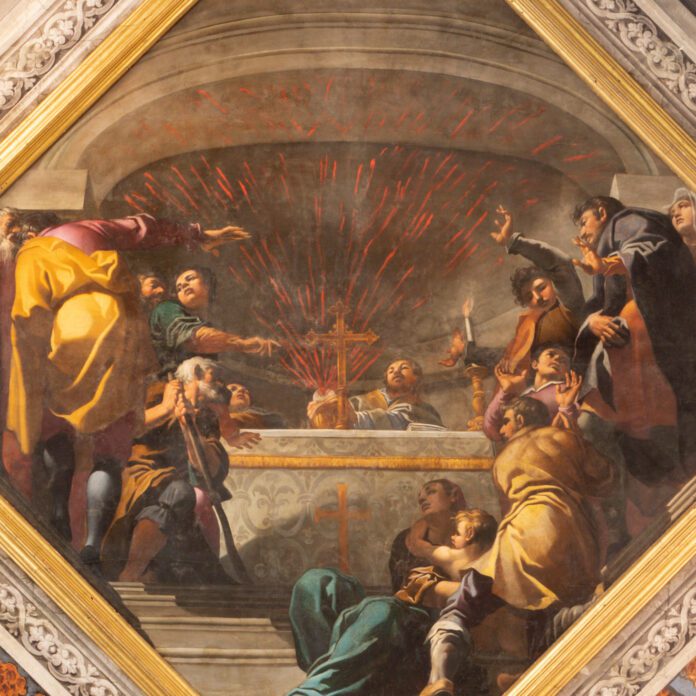In the 8th century, there was a monastery of Basilians (monks of St. Basil) in the city of Anxanum (a city southeast of Rome that is now called Lanciano). The monastery was under the patronage of St. Longinus who tradition recognizes as the centurion who pierced the heart of Jesus from which blood and water poured out and proclaimed Jesus as the Son of God shortly after His death. One day a monk who was having serious doubts about the true presence of Jesus in the Eucharist was celebrating mass. However during the words of consecration, the bread in his hands changed into actual flesh and the wine in the chalice changed to actual blood. Astounded, the monk began to weep in joy and called the entire congregation to the altar to witness the miraculous event. He admitted his previous doubts and praised God for the miracle that had just changed his heart.
After investigation by the Archbishop, the miracle was approved by the Church. In his investigation, the Archbishop found that the host that had changed into physical flesh had stayed the same, but the blood in the chalice had coagulated into five separate globules of various sizes. The flesh and blood were stored in an ivory reliquary and were taken care of by the Basilians, Benedictines, and finally the Francisicans throughout the centuries. In the 18th century, the Flesh was moved from the ivory reliquary to a silver monstrance. The globules were moved to a crystal chalice. It is in these containers that they are still on display today.
In 1970, modern medical scientists had the chance to study the flesh and globules over the span of 15 months. Dr. Odoardo Linoli who was assisted by Dr. Ruggero Bertelli confirmed the previous findings and added more incredible details. The flesh was found to be muscle tissue from a human heart. The specific section of the heart would have to have been extracted by an extremely skilled surgeon. The flesh had undergone rigor mortis which meant that at one point the flesh was living (likely during the original miracle in the 8th century), had died, but did not decay. A study of the globules revealed the blood type to be AB and matched the characteristics of a man who was born and lived in the Middle East region. The blood also matched the blood found on the Shroud of Turin. Despite all of these incredible discoveries, no preservatives were found in the flesh or blood. The findings of Drs. Linoli and Bertelli have been confirmed by the World Health Organization, asserting that there is no scientific explanation for the phenomenon.
It is completely understandable that the Basilian monk from the 8th century had his doubts about the Eucharist, especially if His life was consumed by worldly wisdom. However, in the weakness of His doubts, God’s grace had abounded all the more. He poured out proof of His true presence in the Eucharist that is scientifically verified throughout the centuries even to this day.
Originally published in Prime Soil Magazine | Vol. 1 No. 2
Originally presented at The 10th National Eucharistic Congress in July 2024






